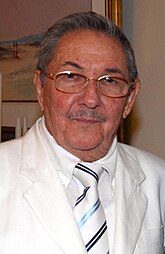Prime Minister of Cuba
| President of the Council of Ministers of Cuba Presidente del Consejo de Ministros de Cuba |
|
|---|---|

Official Standard
|
|
| Style | Premier (informal) |
| Member of |
Council of Ministers, Council of State |
| Seat | Havana |
| Appointer | National Assembly of People's Power |
| Term length | None The Prime Minister's term of office ends like the President of Cuba |
| Inaugural holder | Carlos Saladrigas Zayas |
| Formation | 10 October 1940 |
| Website | www |
The Prime Minister of Cuba (Spanish: Primer Ministro de Cuba), officially called from 1976 President of the Council of Ministers (Spanish: Presidente del Consejo de Ministros de Cuba), is the head of the Council of Ministers of Cuba. The current office is established under the Constitution of 1976. Fidel Castro assumed the position of Prime Minister in 1959, replacing José Miró Cardona.
The office was officially changed on December 2, 1976 following a restructuring of the government and the implementation of a new Constitution of Cuba. Castro became president of the Council of State (President of Cuba) and president of the Council of ministers, elected by the National Assembly. The Prime Minister of Cuba was also referred to as the Premier. The role of President of the Council of Ministers is sometimes still referred to as the "prime minister".
The role of the Prime Minister was first assigned in 1940 in accordance with the amended Constitution of Cuba. The first Prime Minister of Cuba was Carlos Saladrigas Zayas (1900–1957), the nephew of former President Alfredo Zayas. Between 1940 and 1959, Cuba saw fifteen changes to the position, Félix Lancís Sánchez was Prime Minister twice (1944–1945 and 1950–1951) whilst Fulgencio Batista held the role concurrently alongside that of President of Cuba for one month (April 1952) following a military coup.
...
Wikipedia

